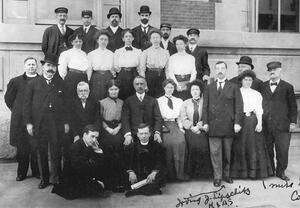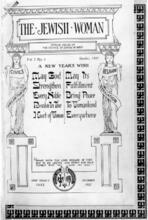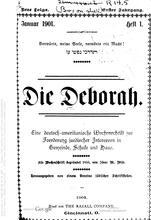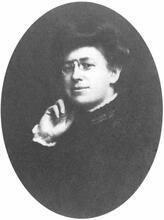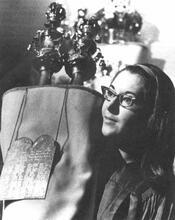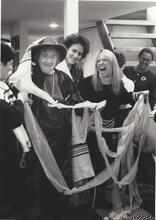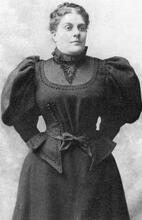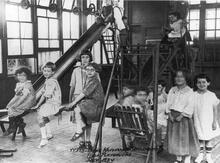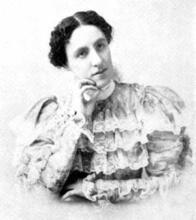Assimilation in the United States: Nineteenth Century
Female German Jewish immigrants were uniquely impacted by both their gender and class during the process of their assimilation to American life. Women aided their families’ economic stability, but they also contributed to the social and charitable activities of the Jewish immigrant community. However, over time, Jewish women’s social work slowly secularized, reflecting the women’s increased sense of personal autonomy, which occurred at the same time that these women were achieving greater financial affluence. This shift was also influenced by the increasing prevalence of Reform Judaism in the mid-nineteenth century and the comparable social work of the American Protestant community in the same period. Through their work, German Jewish women immigrants preserved Jewish tradition and expanded their roles beyond the home.
Introduction
Scholars have conventionally considered the nineteenth century the German era in the American Jewish history. Between 1820 and 1880, more than 200,000 immigrants from German lands arrived in the United States. Besides German Jews, this transatlantic movement also included migrants from ethnically Czech, Hungarian, Polish, and Baltic territories that at that time remained under German political control or cultural influence. Because German Jews were a decisive majority among the immigrants and because, together with their American-born children, they played a central role in the assimilation/Americanization of their communities almost until World War I, they are the focus of this article.
In the social science literature on immigration and ethnicity, the term assimilation has been assigned various meanings. In contrast to the conventional understanding of this concept in which Old Country bonds, customs, and attachments are gradually replaced by mainstream American ways, assimilation is viewed here as a process whereby blended or ethnic—in this case, Jewish-American—identities, life-styles, and patterns of social relations emerge in the interplay between the immigrant group’s traditions and resources and those of the host society as they are adapted and used by the immigrants in pursuit of their goals. The effect of the assimilation process on the social actors and their environment allows flexibility and variety in the ethnic blends, depending on the social-historical conditions in which they take shape.
Two related social circumstances in particular influence the forms and contents of ethnic blends as they evolve in specific periods and locations. Coined by sociologist Milton Gordon, the term ethclass denotes the inescapable class nature of assimilation. More recently, a similar idea of assimilation’s inherent genderedness was elaborated by Paula Hyman.
Impact of Gender
The assimilation-as-ethnicization of German Jewish women occurred as they confronted and acted upon the opportunities and constraints of the American environment by adapting, mixing, and reconfiguring their Jewish and the American class-gender role expectations, activities, and symbolic resources. German Jewish immigrants in America had a double cultural identity since the Jews’ assimilation in Germany had progressed through the nineteenth century, and the later they left their home country, the more likely they were to have been such cultural hybrids.
The two aspects of class and gender in the assimilation-ethnicization processes united with the historically situated gender and ethnic specificity of class position and the ethnic specificity of gender roles, and relations of German Jewish women throughout the nineteenth century were influenced from the outside by the larger American environment, in particular the voluntary and democratic character of its social associations, and by its political culture and practice based on the principles of individual liberty. On the inside, two major developments in the American German Jewish society were shaped by the Americanization of its female members.
The first was the moving into the middle class of German Jews that resulted from the fortuitous convergence of the demands of the expanding American economy with the supply by the Jews of particular skills and sociocultural resources. This upward movement on the mainstream socioeconomic ladder made the middle-class Anglo-Protestant women the reference model for the assimilation-ethnicization of their German Jewish counterparts.
The second development was the emergence of American Reform Judaism modeled in considerable part on contemporary American middle-class Protestantism, in whose philosophy and institutional functioning women occupied a position significantly different from that prescribed by the traditional (Orthodox) Jewish religion. As these two developments made it possible for women to assume new, ethnic-American roles and activities in their homes and immigrant communities, the women, in turn, transformed, or Americanized, private and public spheres of the German Jewish society. These reciprocal transformations were cumulative, building upon the preceding changes.
Most of the German Jews who began to arrive in the United States in increasing numbers in the 1820s and 1830s were pushed out of their small towns by the economic modernization of Central Europe and, specifically, the structural relocations that undermined their livelihoods that had been drawn from petty trading in rural areas. An additional hardship and reason for emigration was the prohibition against marrying without sufficient means, imposed by the newly instituted legal limitations on Jewish marriage.
Young single men constituted the majority of immigrants, especially in the initial phase of transplantation, before they established themselves sufficiently to bring over their families or to marry. These young single men with entrepreneurial skills joined the west- and southbound frontier movement of native-born Americans and contributed to the early dispersal of German Jewish communities across the United States. This was quite a different pattern from the much greater urban concentration both of their Descendants of the Jews who lived in Spain and Portugal before the explusion of 1492; primarily Jews of N. Africa, Italy, the Middle East and the Balkans.Sephardi predecessors and their East European followers to America.
Peddling, followed by the establishment of a stationary business, was the typical occupation of German Jewish immigrants during the first decades of their settlement in America. As in the Old Country, wives actively participated in the family economy either by managing the family stores or (an American novelty created to accommodate single immigrants) by running boardinghouses. The primary preoccupation of immigrant family members during this initial adaptation to the new environment was, first, securing economic self-sufficiency and, second, gradually growing the business and improving the material standard of living. These efforts absorbed a substantial share of women’s time and energy, especially because American free-for-all capitalism invited and rewarded the vigorous entrepreneurial efforts of new immigrants.
Changing Religious Roles for Women
Women devoted whatever time remained to their homes and families, and to social and charitable activities in the Jewish immigrant community. The traditional Jewish view of the female as “naturally” pious and motivated mainly by concern for others, primarily for her family’s well-being in the home, coincided to a large extent with the role model of the “true woman” that prevailed in mainstream American society in the early nineteenth century. But the characteristics of contemporary American society and the particular circumstances of not-quite-settled Jewish immigrants made the scope and form of women’s domestic piety change or ethnicize soon after they arrived in America.
The main American innovation in religious observance introduced by the immigrants shortly after their arrival in the United States was its significant diminution. In the home, religion as practiced by women meant, first and foremost, the trimming down or even elimination of The Jewish dietary laws delineating the permissible types of food and methods of their preparation.kashrut —the time-consuming and complicated observance of Jewish dietary laws. Particularly consequential in this development was the appearance, for the first time for most of the women in the religious sphere, of individual choice whether to use more- or less-strict ways of managing the kitchen.
This erosion in women’s traditional piety was primarily a response to the new circumstances of their own lives, as well as of the collective situation of German Jewish immigrants in America. They were also responding to the fluidity of the larger (host) society in the making and the voluntary basis of its operation. As well, the immigrants frequently moved and lacked rabbinic leadership. Although religious “from the roots,” to use Barbara Myerhoff’s apt phrase, most of them, especially the early arrivals, did not have much Jewish education.
Another, related factor that contributed to the attrition in observance by Jewish women of traditional home religious rituals was the increased influence of Reform Judaism. Its philosophical and practical purpose was to modernize Jewish religion by eliminating the characteristics that set apart its practitioners from mainstream (Christian) society. Originated in Germany at the beginning of the nineteenth century by Jewish philosophers as the emancipation project “from within,” Reform Judaism found in liberal-democratic America a particularly hospitable ground and, among Americanizing German Jews, eager followers. Because of close ideological links with the Reform movement in Germany, however, the modernizing effects of American Reform Judaism, in this case, loosening home religious observance and letting women decide the scope and “grasp” of their piety, must be considered, during the early nineteenth century, as both Americanizing and Germanizing. The latter influence was strengthened, at least temporally, by the arrival from Germany in the 1840s and 1850s of Jewish immigrants who were more educated in mainstream German culture.
Together with the increase in the flexibility of women’s piety practiced at home, an incipient development in the middle of the nineteenth century began to refocus the central role of the woman and the home and family in the preservation of Jewishness in America. Combining elements of Jewish tradition and influences of the dominant middle-class American culture, especially the model of the segregated, male-public, and female-private spheres, the ascending gender ideology of German Jewish immigrant society called on the woman, viewed as endowed with natural moral sense, to act as the main agent and carrier of Jewish tradition and made the home into the center of moral-religious education and the well of Jewish spirituality. Although this Americanized-ethnicized role model assigned women to their gender-specific sphere, as they established themselves in it, they saw and acted on the possibilities to redraw the boundaries and undertake new and different initiatives.
Women and Social Work
Besides piety and good care of the home as primary obligations, the nineteenth-century American female role model called upon women to do charitable work for the sick and the needy. In this case, too, the overlapping gender prescriptions of the American ideal and the Jewish commandment of Lit. "righteousness" or "justice." Charityzedakah, charitable deeds, aided the immigrant women’s acculturation to the dominant society’s gender role model. Yet both the American (specifically, Protestant American) moral ideal of “the charitable woman” and, parallel to it, the Jewish one, were being challenged and modified, as it were, from below by the very actors whose gender roles they defined. For immigrant women, this challenge-and-modify process involved at the same time classgendethnicization of traditional Jewish ways.
The major American innovation in this area was the gradual transformation of the traditional hevrot nashim, informal women’s groups devoted to the fulfillment of the obligation of zedakah, into self-governing voluntary philanthropic women’s organizations. This change at once reflected and expressed the collective ascent of German Jewish immigrant families from the ranks of petty entrepreneurs into the mainstream middle class and their acculturation to the dominant middle-class lifestyles that had accelerated since mid-century.
The most common kind of women’s charity work in the German Jewish immigrant communities during the early nineteenth century, the activities of hevrot nashim, included besides the traditional ritual preparation of the dead (females) for burial also visiting the sick, assisting migrants, and charitable relief for the poor. But by the 1820s and 1830s, initiated by upper-middle-class Jewish women in larger cities, a new ethnic organization had appeared, American in form and Jewish in content, which by the 1850s became the dominant institutional channel of women’s charitable work: the Ladies’ Hebrew Benevolent Society.
Jewish women’s benevolent societies continued to perform the traditional functions of the hevrot nashim but in significantly modified ways. These associations were based on voluntary membership rather than obligation, and their operation was based on written by-laws and established democratic procedures rather than informal interactions. In another important innovation, society members controlled their own financial means, which were generated by dues-paying subscribers and by another American novelty, fund-raising events such as “dime parties,” theatricals, or “strawberry socials.” Ladies’ benevolent societies contributed such income to the needs of their congregations.
Whereas initially female benevolent associations were affiliated with synagogues and often had male chief officers, with time, both reflecting and contributing to the Jewish women’s growing sense of personal and collective autonomy, they became independent and were managed solely by their female members. The first nonsynagogual female Jewish society was founded in 1819 by Rebecca Gratz, a member of the Philadelphia Jewish upper class and an exceptionally independent-minded woman for her time. Such autonomous and self-governing Jewish women’s benevolent associations proliferated earlier and more quickly in America’s West, where societal structures were more flexible and people’s ways less fixed than in the more settled East.
The gradual separation of Jewish female philanthropic societies from the synagogues as a cause-and-effect of women’s increased sense of personal and collective autonomy was also a reflection, inside the acculturating German Jewish group, of the broader processes of secularization and institutional differentiation of American society. The appearance, by mid-century, of secular middle-class Jewish female clubs exemplified these developments. Their quick spread in German Jewish communities was further facilitated by the considerable amount of free time gained by middle-class housewives as they retreated from economic activities.
Modeled after the sociocultural associations of middle-class Anglo-American women, but addressing German Jewish American concerns and interests, these clubs are a good illustration of classgendethnicization of German Jewish women’s lives in nineteenth-century America. The first such club, the United Order of True Sisters, was founded in 1846 in New York and by 1851 had spread to Philadelphia, Albany, and New Haven. Its purpose was mutual help (structured after the male B’nai B’rith fraternal lodge founded three years earlier), gaining knowledge about “current arts and affairs” as well as “foster[ing] solidarity among the women [of the club].” As they grew, German Jewish women’s clubs added to their activities study circles whose purpose was self-education in Judaic lore and philanthropic pursuits that with time turned into social work.
Characteristic of this transformation of Jewish women’s traditional A biblical or rabbinic commandment; also, a good deed.mitzvah of zedakah into independent and self-governing voluntary associations with multiple purposes was that it was a quiet revolution, a major change in the sociocultural order accomplished without its breakdown. The female agents of this transformation did not explicitly challenge the separate-spheres model, but as did their American Protestant sisters, they redrew the boundaries and thus altered the landscape of the female domestic realm by moving it into the public sphere of their ethnoreligious communities.
Public Religious Life
As women entered into the sphere of the secular public life of German Jewish communities, another important process with similar consequences was taking place in mid-century—the female entry into the realm that had been the exclusive preserve of men, the synagogue, and public religious functions. In the transformation of congregational charities into organized philanthropy, the women themselves had been primary actors enabled by the American conditions and encouraged by the rabbinic leaders of the Reform movement. The latter were more directly instrumental in integrating women into the synagogue—an idea that was the integral component of the religious philosophy of Reform Judaism as formulated by its rabbinic leaders, especially Isaac Mayer Wise and David Einhorn, the authors of two programmatic texts of American Reform, CustomMinhag America (1857) and Olat Tamid (1858), respectively.
Among the implemented changes with the greatest impact on the entrance by women into Reform Judaism’s public religious sphere were the desegregation of the sexes in the synagogues by the introduction of family pews, the admission of women into the The quorum, traditionally of ten adult males over the age of thirteen, required for public synagogue service and several other religious ceremonies.minyan (the ten adults necessary for public prayers to take place), and Jewish education for girls, all of which significantly increased women’s participation in religious services.
These and other innovations of Reform Judaism conceptualized in the late 1840s to early 1850s by German-born and -trained rabbis should be interpreted as simultaneously Germanizing and Americanizing. The latter, in this case the influence of contemporary developments in middle-class American Protestant churches, was reflected in the steady increase in women’s attendance at religious services, so that their numbers first equaled and then exceeded those of men. Another effect of the influence of American-Protestant practices on Jewish “public religion” was, supported by Reform rabbis, a takeover by second-generation women of the religious education of children in the Sunday schools. In turn, Jewish women’s presence and active participation in the public religious sphere had transformed—Americanized—the latter.
Ethnicization
These reciprocal transformations, too, were taking place not through the rejection by Jewish women of the female sphere as defined by the dominant model of gender roles, but by a quiet alteration of accepted understandings as they extended women’s domestic responsibility for the preservation of Jewishness in the home and the family into the synagogue. That it was, precisely, the Americanization of the synagogue that, by making women active participants in its religious activities, contributed to the preservation of Jewish tradition in America is a good illustration of the accommodation of change and continuity in the process of ethnicization.
New developments in American society and in German Jewish communities during the last three decades of the nineteenth century invited new initiatives on the part of Jewish women that, building on the transformations begun earlier in the century, further advanced their Americanization-as-ethnicization. In three areas, these developments brought about the most visible changes in women’s position and activities: (1) the rapid urban-industrial growth of the United States and technological advances, resulting in a greater material affluence and new life-styles for the American middle class; (2) the progressive “feminization of religion” in the American Protestant and German Jewish-American, middle-class societies; and (3) further specialization and, especially, professionalization of public-sphere activities of American, including German Jewish, middle-class women.
A greater surplus of free time American middle-class women in the 1870s to 1890s gained, as the result of general increase in economic affluence, the mechanization of many household tasks, and the proliferation of commercial entertainment, such as vaudeville theaters, dance halls, amusement parks, and the first moving pictures, changed the lifestyles of entire families and their individual members. A distinct and important American innovation in the lifestyles of second-generation German Jewish families, which was both the result and a cause of increased economic affluence and substantially increased women’s free time, was a significant decrease in the number of children they bore on the average (two to three) compared to middle-class Protestant American women.
American material innovations German Jewish women introduced into their middle-class homes included technological novelties such as bathtubs, plumbing, washers, radios, parlor furnishings, and fashionable clothing. Jews, especially women, were apparently particularly concerned with clothing as a symbol of American middle-class status. They were also uncommonly capable and experienced in the clothing business, a “Jewish” trade specialty. The piano, a necessary feature of the typical American middle-class parlor, in Jewish homes was an ethnic expression of both German Jewish tradition and American middle-class membership.
Cultural (material and symbolic) and social ethnicization of family lifestyles allowed by increased middle-class affluence and new developments in household and entertainment technologies that had been introduced and managed by women included innovations such as the use of Jewish-American cookbooks for confirmation receptions, invitation dinners, and Holiday held on the 14th day of the Hebrew month of Adar (on the 15th day in Jerusalem) to commemorate the deliverance of the Jewish people in the Persian empire from a plot to eradicate them.Purim dance parties, and family vacations in Germany (by now an ethnic rather than Germanizing activity). Active involvement of middle-class German Jewish women in settlement houses in the education of recently arrived Eastern European Jewish immigrant women in the American way of life, including modern cooking, sanitary habits, and scientific management of the home, can also be viewed as the expression of Americanization in a double sense. The ways of middle-class American women had been learned by their German Jewish sisters, who, in turn, were passing them on to their fellow ethnic gender-mates.
The progressive secularization of mainstream American social institutions and popular culture and, within American German Jewish society, the shrinking scope of the sacred in people’s everyday lives as Reform Judaism significantly diminished and voluntarized religious observance, caused Jewish religious leaders to rely more than before on women for help. Echoing the American (Protestant) notion of womanhood as the natural wellspring of spirituality, Reform rabbis called upon Jewish women, “more responsive,” in the words of Rabbi Kaufmann Kohler, the main architect of the Reform movement’s Pittsburgh Platform (1885), “to the tender appeals of religious duty,” to become “the saviors of Jewish religion.” Similar normative representations of women as the bearers of Jewish tradition had come from the women themselves during their organizational meetings, in Jewish-American publications, and in literary works.
Declaring women to be Judaism’s saviors indicated the major reversal—the culmination of a long-term process of Americanization-as-ethnicization begun in the early 1800s—of traditional Jewish gender roles, wherein women were defined at best as men’s helpmates. In the home, middle-class German Jewish women—mostly second generation and much better educated in Judaism than their immigrant mothers—had assumed control of children’s religious education, supervised their confirmation studies, and suggested interesting readings on Jewish religion.
Perhaps more dramatic because it lay in traditional male territory was the further redrawing of gender boundaries in synagogue life. Women as “saviors of Jewish religion” had assumed many diversified responsibilities as officers of religious school boards, and through fund-raising, community, educational, and sociocultural activities, of temple sisterhoods. Organized locally in the 1880s and 1890s, they formed a national federation in 1913. The most far-fetched, indeed, revolutionary challenge to traditional gender roles in Jewish public religion was, parallel to contemporary developments in middle-class American Protestantism, a debate in the rabbinic and lay (including women) Reform circles in the 1890s concerning women’s ordination. Although it was not formally instituted until 1972, at the turn of the century, particularly in the more open West, unordained women preachers (Ray Frank was the most famous) conducted services in West Coast Jewish communities where there were no rabbis.
Three features of the expanding public nature of Jewish women’s activities came into sharp relief at the close of the century. First, Americanization of women’s roles involved at once innovations in the scope and content of their undertakings and purposeful action to preserve Jewish tradition.
Second, illustrating ethnicization again as the fusing of continuity and change, even quite radical reconfigurations of traditional gender roles were presented by female advocates of these innovations in the rhetoric of familiar domesticity. Evocations of the biblical images of the “Mothers of Israel” following in the footsteps of Jochebed, Miriam, and Deborah in the representations of women’s expanding presence and responsibilities in the forum of Jewish public religion sustained in observers and participants alike a sense of the continuity of Jewish tradition.
Third, whereas the assumption by women of new and important responsibilities in public religion, the area of great symbolic importance for Jewish identity, had Americanizing-ethnicizing effects by enhancing their sense of individual and collective (gender) self-worth and shared purpose, these new responsibilities and enhanced self-esteem of women reciprocally transformed, or Americanized-ethnicized, the ideas and practices of Reform Judaism.
In the secular public forum, new avenues for German Jewish women’s pursuits in the late nineteenth century were opened, on the one hand, by the professionalization of American middle-class women’s education, especially in the fields of teaching and social work, and, on the other hand, by the ideology and practice of Progressive reform movement to which lay and clergy, middle-class Americans, Protestant and Jewish Reform, actively committed themselves. Aimed at eradicating urban poverty and crime and (re)instituting social justice when it fell victim to predatory capitalism, the Progressive reform movement had been an outspokenly moral campaign and as such naturally appealed to women in whose gender role model moral vocation occupied central place.
This affinity between women and social reform combined with professional training in social work and education and with the sociocultural capital accumulated in the earlier phase of women’s club work—organizational experience, self-confidence, and gender support networks—greatly facilitated the creation in the 1890s of what Robyn Muncy has called “a female dominion in the American Reform.” Urban neighborhoods, swelling at the turn of the century with new immigrants from Southern and Eastern Europe, provided a ready target for middle-class women reformers. The attention of German Jewish women educators and social workers naturally turned to recent Jewish arrivals from Russia and Austro-Hungary who had settled in densely populated immigrant sections in New York and other large cities in the East and Midwest.
The main foci of German Jewish women’s activities and a new institutional sphere under their autonomous control were neighborhood settlement houses, among the most renowned, Lillian Wald’s Henry Street Settlement (founded in 1893) and the Clara de Hirsch Home for Working Girls (1897) in New York. The programs of settlement homes managed by German Jewish women combined American and Jewish elements. The former, modeled after the activities of the American Protestant institutions, in particular the prototypical Chicago Hull House of Jane Adams, included vocational training programs for working immigrant girls and education in American middle-class female skills such as household science, personal hygiene, and etiquette and refinement. The latter were the ways of proper Jewish womanhood taught to Eastern European immigrant girls, including the modern Term used for ritually untainted food according to the laws of Kashrut (Jewish dietary laws).kosher kitchen, observance of Jewish holidays, and morals and appropriate Jewish gender attitudes.
National Council of Jewish Women
Inspired by the new science of philanthropy propagated by American Protestant social workers and by specifically Jewish purposes, the first nationwide Jewish women’s organization in America, the National Council Of Jewish Women (NCJW), actively joined settlement work. NCJW was founded in 1893, during a Jewish Women’s Congress organized under the auspices of the World’s Parliament of Religions held at the Chicago World’s Fair. The Jewish Women’s Congress itself, its key speakers (single women who were teachers and social workers), and its discussion topics (which ranged from “Religion in the Home” to “Women as Wage Workers” and “Women against Child Factory Labor”), exemplified a new development in the Americanization-as-ethnicization of German Jewish women’s social position and their activities.
NCJW set as its main objectives solidification of members’ religious-cultural identity through the systematic study of Judaism and religious and educational work among Jewish working-class children and youth. In consultation with leaders such as Jane Addams and Lillian Wald, the council opened settlement houses in immigrant neighborhoods in more than one dozen cities. As perceived by NCJW, the goal of its settlement work resembled ethnicization, namely, “gradual assimilation and the recognition of the need to create a sense of continuity between the old and the new in an atmosphere of mutual respect, toleration, and understanding,” as stated in Faith Rogow’s Gone to Another Meeting.
The NCJW’s settlement work led to the involvement of its members in mainstream American public institutions such as schools, juvenile courts, and medical centers. These institutions fell, by and large, in the purview of the domestic care-and-nurture sphere that constituted the then recognized culturally female dominion. NCJW leaders themselves insisted that social welfare work, within and without the German Jewish community, was simply an extension of motherhood. But even when justified as falling into the domestic sphere, further redrawing of the boundaries of Jewish women’s public activities by the inclusion of the realm outside the ethnic community constituted the next important step in their assimilation. In collaboration with American Protestant clubwomen, council locals joined political campaigns for women’s causes such as improved education and job opportunities for women, and Progressive social justice crusades for delegalization of child factory labor, minimum wages, and humane working conditions.
At the same time, in a reconfirmation of the hybrid general (American) and particular (Jewish) assimilation that had characterized German Jewish women’s adaptation in America since the beginning of the nineteenth century, NCJW pursued its own ethnic agenda (contradictory to the concerns expressed by middle-class American Protestant clubwomen), by defending the open-door immigration policy of the U.S. Government, and by lobbying for the improvement of living conditions of immigrant families in urban centers.
Analysis
The adherence of late nineteenth-century middle-class American women to the accepted notions of womanhood in public self-representations and in interpretations of their expanding public activities, namely, making women’s moral sensibility the justification for their responsibility for the perfection of society, has been dubbed by scholars as “domestic feminism.” German Jewish women did not differ in their approach from their American Protestant sisters. They, too, presented themselves and their activities in terms of the then prevailing concept of femininity, which, in their case, included a distinctive Jewish component. Turn-of-the-century Jewish domestic feminism, however, testified to the long distance traveled by German Jewish women from hevrot nashim of the 1820s to the greatly augmented scope and diversified forms and content of their religious and secular activities, gains in personal autonomy and self-confidence, the emergence of a collective identity based on class, gender, and ethnicity, and a sense of public responsibility.
Facilitating these changes in women’s lives were long-term influences of the democratic functioning of American society and the principle of individual rights informing its laws and culture. The transformation during the nineteenth century of American German Jewish society, especially its collective ascent to the middle class and the economic and cultural consequences thereof, and the emergence and spread of Reform Judaism also significantly contributed to the changes in women’s lives.
Conversely, as their activities expanded and self-confidence strengthened, the women transformed the German Jewish community as well. The American German Jewish community of the 1900s in which middle-class women hosted receptions in their parlors, managed public religious life as saviors of Judaism, busied themselves as professional social workers, organized women’s congresses, and collaborated with American Protestant women in political campaigns differed dramatically from its “grandmother” of seventy-five years earlier in which women were mainly preoccupied with caring for numerous children at home, helping their husbands in family stores, and traditional tzedaka in the congregation. Jewish women Americanized-ethnicized themselves and their communities not solely as agents of change, however, but also simultaneously as agents for the preservation of Jewish tradition.
Baum, Charlotte, Paula Hyman, and Sonya Michel. “Assimilation Was Their Goal: The German Jewish Woman in America.” In The Jewish Woman in America (1976).
Blair, Karen. The Clubwoman as Feminist: True Womanhood Redefined, 1868–1914 (1980).
Cohen, Naomi. Encounter With Emancipation: The German Jews in the United States, 1830–1914 (1981).
Diner, Hasia. A Time for Gathering: The Second Migration 1820–1880 (1992).
Glanz, Rudolph. The Jewish Woman in America: Two Female Immigrant Generations, 1820–1929. Vol. 1, The Eastern European Jewish Woman, and Vol. 2, The German Jewish Woman (1976).
Goldman, Karla. “The Ambivalence of Reform Judaism: Kaufmann Kohler and the Ideal Jewish Woman.” AJH 4 (1990): 477–499.
Golomb, Deborah Grand. “The 1893 Congress of Jewish Women: Evolution or Revolution in American Jewish Women’s History?” AJH 1 (1980): 52–67.
Gordon, Milton. Assimilation in American Life (1964).
Hargrove, Barbara, Jean Miller Schmidt, and Sheila Greeve Davaney. “Religion and the Changing Role of Women.” The Annals of the American Academy of Political and Social Science 480 (1985): 117–31.
Heinze, Andrew. Adapting to Abundance: Jewish Immigrants, Mass Consumption, and the Search for American Identity (1990).
Hyman, Paula. Gender and Assimilation in Modern Jewish History: The Roles and Representations of Women (1995).
Kuzmack, Linda Gordon. Woman’s Cause: The Jewish Woman’s Movement in England and the United States, 1881–1933 (1990).
Marcus, Jacob Rader, ed. The American Jewish Woman: A Documentary History (1981).
Meyer, Michael. Response to Modernity: A History of the Reform Movement in Judaism (1988).
Morawska, Ewa. “The Sociology and Historiography of Immigration.” In Immigration Reconsidered: History, Sociology, and Politics, edited by Virginia Yans-McLaughlin (1990).
Muncy, Robyn. Creating a Female Dominion in American Reform, 1890–1935 (1991).
Nadell, Pamela, and Rita Simon. “Ladies of the Sisterhood: Women in the American Reform Synagogue, 1990–1930.” In Active Voices: Women in Jewish Culture, edited by Maurie Sacks (1995).
Rogow, Faith. Gone to Another Meeting: The National Council of Jewish Women, 1893–1993 (1993).
Sinkoff, Nancy. “Educating for ‘Proper’ Jewish Womanhood: A Case Study in Domesticity and Vocational Training, 1897–1926.” AJH 3 (1988): 572–599.
Sochen, June Miller. Consecrate Every Day: The Public Lives of Jewish American Women, 1880–1980 (1981).
Strauss, Herbert. “The Immigration and Acculturation of the German Jew in the United States of America.” Leo Baeck Institute Year Book (1971): 63–96.
Toll, William. “A Quiet Revolution: Jewish Women’s Clubs and the Widening Female Sphere, 1870–1920.” AJA 1 (1989): 9–26.
Welter, Barbara. “The Feminization of American Religion: 1800–1860.” In Clio’s Consciousness Raised, edited by Mary Hartman and Lois Banner (1974).
Wenger, Beth. “Jewish Women and Voluntarism: Beyond the Myth of Enablers.” AJH 1 (1989): 16–36.

